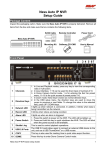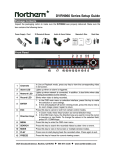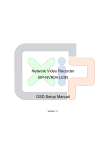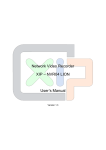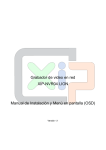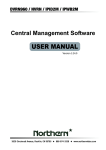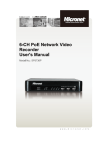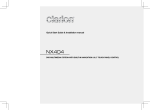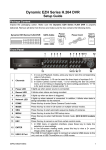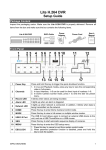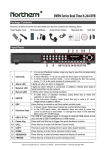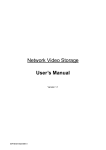Download XIP – NVR04 LION Setup Guide
Transcript
XIP – NVR04 LION Setup Guide Package Content Inspect the packaging carton. Make sure the XIP – NVR04 LION is properly delivered. Remove all items from the box and make sure the box contains the following items. Power Adaptor Control Power Cord Setup Guide Software CD XIP – NVR04 LION USB Mouse Front Panel 1 USB 2.0 Port 2 Record LED 3 Alarm LED 4 Network LED The USB 2.0 port allows users to connect an external USB device to the unit, such as a USB ThumbDrive® or a USB mouse. It blinks when videos are being recorded. It lights up when an alarm is triggered. It lights up when network is connected. In addition, it blinks when data is being transmitted via the network. 1 Rear Panel 1 Main Monitor (VGA) 2 LAN 10/100M (RJ-45) 3 USB 2.0 Ports 4 PoE Ports 5 6 Main Monitor Audio Out Main Monitor (HDMI) 7 Power Jack 8 Power Switch A VGA output connector is for connecting to a VGA main monitor. The NVR is capable of networking and it allows the videos to be viewed over the LAN network or the Internet by using the Internet Explorer. The USB 2.0 ports allow users to connect external USB devices to the unit, such as a USB ThumbDrive® or a USB mouse. The PoE ports offer direct connections to 4 IP cameras for 4CH models, and 8 IP cameras for 8CH models. The IP cameras can be “plug and play” if the function is enabled in the OSD menu. An RCA connector is provided to output audio associated with the main monitor. An HDMI connector is provided for connection to a displaying device that transmits data digitally to show the best video quality. Connect the power supply cord shipped with the NVR. Use of other power supply cords may cause overloading. 1. Switch it on to power on the NVR. 2. After shutting down the NVR system from the OSD main menu, switch it off to power off the NVR. NOTE: Currently, the “plug and play” function is only supported for specific IP camera models. Please contact the supplier for more information. Furthermore, the IP address of the IP cameras has to be set to default or static before connecting to the NVR. Otherwise, the NVR will not be able to recognize the existence of the IP cameras. 2 Live Panel Buttons The functional buttons are displayed in the Live Panel when the mouse pointer moves to the right of the screen. Refer to the chart below for definition of each button. Item Icon Description Item 1 Enter 2 Icon Description Item Icon Description 6 Up 10 Esc Left 7 Down 11 Right 3 Mode 8 Freeze 12 Search 4 Play/Stop 9 Sequence 13 Menu 5 Dome Camera Control NOTE: The item 9 <Sequence> is only supported by 8CH models. IP Camera Status Icons The table below describes the connection status of IP camera at Live mode. Icon Description Icon Description Connecting IP Camera Successful Connection Failed Connection Resolution Oversize Icon Description No Connection Power On the NVR Please follow the proper power on procedures to avoid damaging the NVR. Connect all necessary components, e.g. monitor and cameras, before power on the NVR. Check the type of power source before plugging in the power cord to the NVR. The acceptable power input is between AC110V ~ AC240V. Switch on the power switch on the rear panel to power on the NVR. NOTE: Connect all IP cameras before powering on the NVR. It takes about 4 minutes for a 4CH model NVR to power on, and display the images from all IP cameras. While it takes 4CH models about 4 minutes, the process may be slightly longer for 8CH models. The amount of time may vary according to different IP camera models. 3 Select Viewing Mode: Click on MODE repeatedly to select a preferred display mode. The available viewing modes are full-screen, 4-window, and 9-window (8CH models only). Refer to the User’s Manual for more details. Click on FREEZE to pause the current viewing image. Basic Setup Enter the OSD main menu and setup some basic configuration of the NVR. The basic configuration can be set via either the NVR or NVRRemote, the remote software. Enter OSD Main Menu: Click on MENU to enter the OSD main menu. Select the administrator account “admin” to login. Enter the preset password “1234”. It is strongly suggested to change the password to prevent unauthorized access. Date / Time Setting: Follow steps below to setup date/time before the recording starts. Refer to the User’s Manual for advanced setup of Time Sync function. Select <Date/Time> in the System menu. Select date or time, and adjust the value by clicking on the UP / DOWN buttons. The new date and time settings take effect after the changes are confirmed. Language Setting: If users wish to change the language of the NVR system, follow the steps below. Select <Language> in the System menu. Click on the DOWN buttons to choose the desired language. Network Setup Configure the LAN setup for the NVR to properly function with Ethernet connection. The default ID of the UltraEco H.264 NVR must be changed to avoid network conflicts. From the OSD main menu, select <System> <Network Setup>, set the <LAN Select> item to <LAN> or <PPPoE> according to the network application, and enter <LAN Setup>. For DHCP users, set the DHCP to <ON>. The IP address, Netmask, Gateway and DNS settings are retrieved from network servers. DHCP is dynamic that the settings change from time to time. For Non-DHCP users, set the DHCP to <OFF>. IP address, Netmask, Gateway and DNS settings must be set. Please obtain the information from the network service provider. To change the IP address, Netmask, Gateway and DNS value, click on the <Num> button to display the number pad and input users’ preferred setting values. PPPoE users must set the <PPPoE Account>, <PPPoE Password>, and <PPPoE Max Idle>. When the settings are complete, click on the item again to confirm and save the settings, or right click to abort. 4 Dome Camera Control Dome Camera Connection: Refer to the following figures. Connect the dome camera to any PoE port of the NVR via an RJ-45 Ethernet cable. The PoE ports of 4CH models supply a total of 30W power source, while the PoE ports of 8CH models supply a total of 60W power source. Each port is limited to at most 15W usage. If the connected dome camera requires power exceeding the limited power source, please connect an additional power source. NOTE: The 30W / 60W power is shared by all ports, but not equally shared. Take 4CH models for example, if the first two ports used up to 15W, the maximum of each port, the remaining ports will not have power supply. Thus, the remaining ports will just be network connection ports. Control Buttons in Dome Camera Control Panel: Icon Description Icon Description Icon Description Iris Open Iris Close Focus Near Focus Far Zoom Out Zoom In Set / Go Preset Points Return to Live Mode Move the Lens to the Left Move the Lens to the Right Move Up the Lens Move Down the Lens Auto Focus 5 Basic Playback Operation Search By Time: Click on SEARCH to enter the Search menu. Click on “From” and playback will start from the specified “From” time. Click on “End” and playback will start from the specified “End” time. Click on “Select” and choose date or time field. Click on the UP / DOWN buttons to adjust the values. Click on “Select” again to confirm or right click to abort. Click on <Begin Playback> to start playing back recorded video of the selected time. Click on PLAY/STOP again to return to live video. NOTE: If there is no available recorded video that matches the specified time and date, the unit starts to playback from the next available video. Calendar Search: Click on SEARCH to enter the Search menu. Click on <Calendar Search> and a calendar will show up. Select any date shown in underlined font, which means recording data are available. The table shown on the left will display available videos of each channel within the selected date. The videos are classified into four categories: Normal, Motion, Alarm In and Video Loss, shown as four different tabs on the top. Then select a preferred time from the time bar. Alternatively, specify the values of date / hour / minute / second under <Select> on the right. The <From> and <End> buttons allows users to playback video from the beginning or end of the database. Click on <Begin Playback> to start playing back the selected video. Search by Event: Click on SEARCH to enter the Search menu. To search event video that was recorded on a specific camera, check or un-check the box in front of a channel to select or de-select the channel. Click on <Event List> to list the event video of the selected channels. The list displays each event by date, time, triggered camera and alarm type. The latest recorded event video will be listed on the top. To exit the event list, right click the mouse. Click on the buttons below to view the previous or next pages of the Event List. Click on the selected event record to playback the event video. NOTE: The event list displays only the first 1024 events; as some events are deleted, others are displayed. 6 Playback Controls of Control Panel Buttons: Icon 12hr Description Icon Description Time Frame of the Previous Time Bar Time Frame of the Next Time Bar Backward Playback: Click repeatedly to increase speed by 1×, 2×, 4×, 8×, 16×, or 32×. Forward Playback: Click repeatedly to increase speed by 1×, 2×, 4×, 8×, 16×, or 32×. Step Backward: Only shows when playback is paused. Step Forward: Only shows when playback is paused. Pause Playback Change Viewing Mode Mark Video Export Time Search Menu Return to Live Mode 4hr Scale Time Bar by 4 Hour Scale Time Bar by 12 Hour 24hr Scale Time Bar by 24 Hour 7 NVR Status Bar Icons Icons that will be displayed in the status bar are listed in the following table with their descriptions. Item Icon Description Item Icon Description 1 Sequence 12 Quick Export 2 Record 13 Stamp A 3 Event Record 14 Stamp B 4 Freeze @ Live Mode 15 Disk Error 5 Dome Camera Control 16 Disk Full 6 Zoom 17 Disk Overheat 7 Pause @ Playback mode 18 No Disk 8 End of Video 19 Disk Almost Full 9 Guest 20 Fan Error 10 Forward Playback Speed: 1x, 2x, 4x, 8x, 16x, 32x 21 HDD Usage 11 Backward Playback Speed: 1x, 2x, 4x, 8x, 16x, 32x 22 User’s Authority Level 8 Connect the NVR via the Remote Software Setup Requirements: Make sure the PC is connected to the Internet. Obtain IP address of the UltraEco H.264 NVR. To check the IP address of the NVR, click on MENU and select <System> <Network Setup> <LAN Setup> <IP> to check the IP. NOTE: The NVR Remote does not support 64 bits IE and IE under Win Metro. NOTE: Make sure the IP address of the NVR is not set to “192.168.50.xxx”. Otherwise, network conflict will occur against the default IP of the built-in PoE hub. Changing Internet Setting: The UltraEco H.264 NVR only supports 32-bit IE browser. However, the NVR does not support IE browser under WinMetro mode. Start the IE; select <Tools> from the main menu of the browser, then <Internet Options> and then click the <Security> tab. Select <Trusted Sites> and click <Sites> to specify its security setting. Uncheck “Require server verification (https :) for all sites in this zone”. Type the IP address of the unit in field and click <Add> to add this website to the zone. In the Security Level area, click <Custom Level>. Under <ActiveX controls and plug-ins>, set all items to <Enable> or <Prompt>. Click <OK> to accept the settings and close the <Security Settings> screen. Using the Remote Software: Start the IE and enter the IP address of the UltraEco H.264 NVR in the address bar. The ActiveX controls and plug-ins dialog will show up twice for confirmation; click <YES> to accept ActiveX plug-ins. The NVRRemote plug-ins will be downloaded and installed on the PC automatically when the connection is successfully made. NOTE: Do not enter any leading “0” characters in the address, for example, “192.068.080.006” should be entered “192.68.80.6”. NOTE: If the default trigger port 80 is changed into another one, take port 81 for example, users should enter the IP address as “192.68.80.6:81”. Version verification starts automatically to verify whether NVRRemote was installed. This process may take up to 30 seconds. When the software is completely downloaded and installed, the Login Screen is displayed. Enter username and password. The default username and password is admin and 1234. 9 The following picture shows the display window of the NVRRemote: Refer to the table below for brief description of functional items: Item 1 2 3 4 5 6 7 8 Description Instant Recording Smoothen the Image Audio On/Off Select Camera Display Mode View Live Camera Playback Video Setup Menu Item 9 10 11 12 13 14 15 16 Description Search Event List Capture Snapshot 4:3 Viewing Aspect HDD Health Status Playback Control Select Picture Size Bandwidth – Normal/Dual Stream Download NVRPlayer For more information on NVRRemote, see User’s Manual. 10 NVRRemote Playback Playback Remote Video: Click <Play> on the main window toolbar, and then <Remote Playback> tab. The <From> and <To> on top of the screen display the date and time from which recorded video is available for playback. Choose <Playback> in <Select> field for playback recorded video. Select the date and time of the segment to play back from the <Start> field. Users can change the date and time either by typing desired numbers directly or using the arrow buttons. Click <OK> to start the playback, or click <Close> to abort. Playback Local *.drv File: Click <Play> on the main window toolbar, and then <Local Playback> tab. Click <Open> and the file selection screen is displayed. Select the *.drv video file to playback and click <OK>. Click <OK> to start the playback, or click <Cancel> to abort. View the video playback using the Playback controls. To end the playback, click <Live> to return to live video. Playback Local *.avi Files: Start the windows media player or other media player from <Start> menu (or any other possible access). Select <File> and then <Open>. Select the wanted *.avi file, and click <Open>. NOTE: The *.avi files for each channel are stored separately. Therefore the video can be played back in single channel, full screen mode only. Playback Event Video: Click SEARCH on the main window toolbar. The Event List appears. Scroll through the Event List and highlight the interested events. Double-click on the desired event to view the event video. Playback Controls: 11











